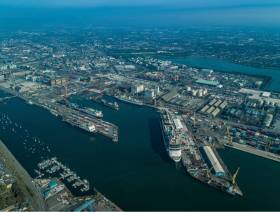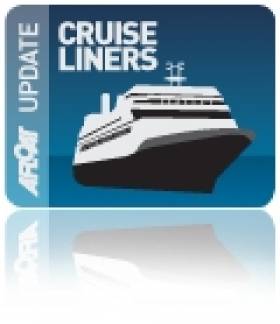Displaying items by tag: Alexandra Basin
Maureen Kennelly, Director of the Arts Council and Eamonn O’Reilly, CEO of the Dublin Port Company on Wednesday (31st August) established a partnership between the Arts Council and DPC with the intention to deliver workspace for artists practicing in all areas of the arts at the port's Flour Mills Master Plan site located in Alexandra Basin.
Artists across Ireland struggle to find suitable workspace but research finds this problem to be most pronounced in Dublin. Dublin City Council undertook research on the provision of Artists Workspaces and infrastructure in the city in 2020 to gain a fuller understanding of the challenges facing artists. This research showed that workshop space is scarce for the 2,500 professional artists working in the city. Artists have worked collaboratively and creatively to address this challenge through ‘artist’ collectives’ but frequently find their efforts hampered by short term and insecure tenancy agreements.
To address the urgent need for more artists' space in Dublin, the Arts Council and Dublin Port Company have been working together since early 2022 to explore options within the Flour Mills Masterplan site. Dublin Port has contracted international award-winning architects, Grafton Architects to undertake a Feasibility Study on the Flour Mill Artists’ Campus on the agreed site. The project is underpinned by the policy objectives of the Arts Council’s 10-year strategy Making Great Art Work, the Government’s Project Ireland 2040 and the Dublin Port Masterplan 2040.
The artists’ campus intends to provide artists’ studios, experimental performing and visual arts spaces, sound proofed rehearsal rooms, workshops, co-working spaces, conference and meeting spaces across 5,000 square meters in the old Odlums Flour Mills area at Dublin Port.
The Arts Council and Dublin Port Company look forward to sharing more details as this exciting project progresses and welcome the official start of a fruitful partnership. The Flour Mill Artists’ Campus has the potential to establish a significant secure and sustainable workspace dedicated to artists within Dublin city. Officials from the Department of Tourism, Culture, Arts, Gaeltacht, Sport and Media have visited the Flour Mills site and recognise the potential of this to be a transformational development for artists. The Arts Council continues to engage closely with Department on the realisation of this remarkable opportunity.
Maureen Kennelly, Director of the Arts Council, commented: “Dublin Port has shown remarkable vision in its support for the arts in recent years and today’s announcement is a further signal of their commitment to the development of a vibrant artistic community in our city. Dublin Port’s vision for a Port City aligns perfectly with the Arts Council’s ambition to create a sustainable and exciting infrastructure for artists to make work. The dynamic promotion of artistic expression in this historic and evolving part of the city will have a profound and positive impact. I would like to particularly salute Eamonn O’Reilly for his immense support of the arts during his time as CEO.”
Prof. Kevin Rafter, Chair of the Arts Council, said: ‘There are huge opportunities in Dublin and other areas around the country to develop new workspaces for artists to address a growing problem. The ambition of Dublin Port to work with the Arts Council is very exciting. This is the start of significant relationship to provide workspaces for artists in the old Flour Mill site in the port and will hopefully provide a model for other organisations to follow.’
Lar Joye, Port Heritage Director, said: “The 15 storey Odlum Flour Mill dominates the skyline of Dublin Port and the study being undertaken by Grafton Architects will create a wonderful space for artists. We are very keen for visitors and now artists to see how the busy Port operates and this project follows on from the very successful development of the Diving Bell museum in 2015, the Pumphouse heritage area in 2020 and Redbrick Sub Station which opens next year”.
Jerry Grant, Chairperson of Dublin Port Company, said: “We are delighted to be working with the Arts Council on this project which further highlights the importance of connecting Dublin Port to the City. Since the launch of the 2040 Masterplan in 2012 we are focused not only on improving port capacity but on furthering Port City Integration. The Board sees this project as an integral part of completing the Dublin Port Masterplan 2040”.
Large Cruiseship Signals ‘End of an Era’ for Irish Cruise Tourism Following Dublin Port Cruise Ban
#cruiseliners - The arrival of thousands of well-travelled North American visitors on a huge cruiseship today could signal the ‘‘end of an era’’ due to actions of the Dublin Port Company, that's according to a group of businesses from across the tourism, retail and transport sectors.
The All-Ireland Cruise Ship Action Group (AICSAG) which was formed to campaign against the ban on cruiseships entering Dublin Port from 2021 has welcomed the influx of visitors due to the arrival of cruiseship Celebrity Reflection in the port today. (Afloat adds even larger capacity cruiseships have docked in the port previously).
Celebrity Reflection which holds 3,600 high-spending passengers from North America, is in Dublin for a ‘turnaround’, an industry term used when one group of passengers leave a cruise ship after a cruise and fly out of Ireland while another group of passengers jet into Dublin to join for a new cruise. Many of these high net worth individuals continue to spend time on the island of Ireland after their cruise ends.
According to AICSAG, turnarounds are believed to be worth up to €100 million to the Irish tourism industry but have now been banned by the Dublin Port Company.
Up until recently, the Dublin Port Company have been extremely active in promoting cruise tourism and were actively marketing to international cruise lines, such as Celebrity.
The decision by the Dublin Port Company to stop cruise ships docking at Dublin Port from 2021 was according to the Group taken without any consultations or engagement with the Minister for Transport, Tourism and Sport, local businesses, Dublin City Council, or the other Irish ports, namely Belfast, Waterford and Cork, who will be severely impacted by this decision.
Cruise companies market Ireland as a destination, and in addition to Dublin large cruise ships often stop off at Belfast, Waterford and Cork. Without access to Dublin Port, cruise companies will no longer stop in other Irish ports and will take hundreds of thousands of passengers out of Ireland to other European destinations.
Afloat.ie today contacted Dublin Port Company which issued the following statement in response to AICSAG.
The berth restrictions we are introducing in 2021 are intended to last three years (i.e. from 2021 to 2023) while we undertake major construction works on a 400 metre quay wall, Alexandra Quay West. (Afloat adds this quay forms part of Alexandra Basin).
As regards the long-term, we have planning permission to develop new berths suitable for cruise ships immediately east of the Tom Clark Bridge [East-Link] at an estimated cost of €100m. This is the subject of a cost benefit analysis study which is currently underway and which will be finished by mid-year.
We intend publishing this study as part of a public consultation process (including with the cruise industry) to ensure that a €100m investment by Dublin Port would be viable. Subject to the outcome of this process, the new berths would be constructed in 2024 / 2025 and be available in 2026.
In addition to the statement, DPC has supplied Afloat.ie with a Briefing Document for the Minister for Transport Shane Ross on Dublin Port’s new cruise ship berthing and pricing policy.
The detailed document published in March, covers many aspects including the Alexandra Basin Redevelopment Project (ABR) and as alluded above new cruise berths [at the North Wall Extension] available in 2026.
Brand New Giant Ro-Ro Makes Use of Dublin's New Flexible Ramp Berth
#dublinport - The brand new Celine, the world's largest short-sea ro-ro freight ferry departed Dublin Port last night having made use of a new ramp linkspan to facilitate such ships, writes Jehan Ashmore.
As previously reported in Afloat's coverage prior to the maiden call of Celine that took place late last month to Ocean Pier in Alexandra Basin (East), the 238m long ship on this most recent call instead docked in the neighbouring larger Alexandra Basin.
The new installed ramp in Alexandra Basin (though not in position during last month's Open House Dublin boat tour) has the capability to be positioned on both Alexandra Quay west or Ocean Pier which it should be noted separates the two basins. The added flexibility of the ramp on both quays is provided given other ships use the basin (including large cruiseships) and so the option of a second ramp access ensures ro-ro freight ferries such as Celine are secured a berth.
To see another photo of the view but taken from Ocean Pier on the Alexandra Basin side, click here from the pre-boat tour coverage. Note in the photo's foreground a deck handrail from CMV's cruiseship, Magellan and ahead of the ship in the background is where Ocean Pier meets Alexandra Quay west.
Traffic on the CLnd /Cobelfret Ferries Celine which operates the Rotterdam-Zeebrugge-Dublin, has provided a major boost in capacity as the 8,000 freight lane metres of deck space will benefit trade between Ireland and mainland Europe.
The investment of both new tonnage by Luxembourg based CLnd along with the Alexandra Basin Redevelopment (ABR) project infrastructure is a measure of confidence in ro-ro traffic, where such trade is provided on direct shipping links to mainland continentel Europe against the backdrop of a post-Brexit UK.
Figures released recently from Dublin Port reported that growth in ro-ro freight was particularly strong with 736,462 units in the first nine months, an increase of 5.3% on the previous year. Within this total, ro-ro services between Ireland and Britain also grew strongly at 6.2% while
Commenting on the trade figures, Eamonn O’Reilly, Chief Executive of Dublin Port said we expect to see more new services to Continental Europe during 2018.
Dublin Port Dredging Plans For Cruise Terminal Project Get Go-Ahead
#DublinPort - Planning permission has been granted for a major dredging scheme at Dublin Port, clearing the final hurdle before works on the proposed new cruise liner terminal for the city.
The application, given the go-ahead by the Environmental Protection Agency (EPA) on Tuesday 13 September, provides for dredging from the North Wall Quay Extension to the -10m Chart Datum contour in Dublin Bay.
It also permits the disposal of dredged material at the existing licensed site west of the Burford Bank – a matter of much controversy this summer due to its location within the special are of conservation from Rockabill to Dalkey Island.
The subsequent Alexandra Basin Redevelopment Project comprises the infilling of the basin at current berths 52 and 53, a deepening of the fairway and a marina protection structure, intended to future-proof the port to accommodate the next generation of cruise liners of more than 300m in length.
Dublin Port's plans advance as Dun Laoghaire awaits the next step in its own harbour masterplan proposals for a modern cruise terminal.
Dundalk Dredger Docked in Dublin Port Is Up for Sale
The Dublin Port Company has sought expressions from interested parties in undertaking the remaining activities of the port on an exclusive basis.
The Dundalk registered dredger arrived to the capital port on 14 July where she remains berthed at the Bulk Jetty in Alexandra Basin. Her previous owners, the Dundalk Port Company were unique in that they were the only port company to own and operate a dredger in the Republic. For many years the 757-tonnes dredger has carried out numerous contract assignments in ports throughout the island of Ireland including work on the Samuel Beckett swing-bridge and the most project was at Queens Quay, Belfast on the Lagan close to the city-centre.
Hebble Sand was launched by Richard (Shipbuilders) of Lowestoft for British Dredging and later used by Associated British Ports to serve a network of UK ports. Despite her age, the near fifty-year-old veteran vessel has been kept in excellent condition and this was evident during a rather unusual appearance for a ship of her type when attending the Dublin Docklands Maritime Festival in 2009.
She was made open for the public amongst the tall-ships that lined the Liffey Quays. Such an initiative was inspiring as it provided a rare opportunity for the public to access such a dredger which otherwise is not familiar compared to the popularity of visiting tall-ships and naval vessels.
The only other port to operate their own dredger is Londonderry Harbour Commissioners, whose Lough Foyle has worked on projects outside her homeport. This has included work at the new £40m Stena Line ferryport terminal on Loch Ryan close to Cairnryan and is due to open in November.
- Dublin Port
- Dublin Port Company
- Dundalk Port Company
- Stena Line
- Port of Dublin
- Ports and Shipping News
- Alexandra Basin
- Ferry news
- Dundalk Port
- Samuel Beckett Bridge
- Dredger Hebble Sand
- Dredger Lough Foyle
- Londonderry Harbour Commissioners
- Samuel Beckett SwingBridge
- Cairnryan ferryport
- Loch Ryan ferry terminal
- Associated British Ports
- ABP
- Richards Shipyard
- Queens Quay Belfast
- Dublin Docklands Maritime Festival 2009
First Cruise-Caller of the Year
Onboard the ship which caters mostly for the UK market, asides the interior facilities there are the outdoor leisure amenities located on the Lounge Deck which has two jacuzzis and an exercise pool. There is also a large swimming pool and weather permitting a poolside buffet is also available at meal times. In addition a circular pool is located on the Marque Deck.
She alongside sister Black Watch belong to a four-ship fleet of the Norwegian owned company. Boudicca was built in 1973 and for many years served as Royal Viking Star as part of a trio of German built sisters for Royal Viking Line. The 205m long vessel underwent her last major refit in 2006.
Boudicca will remain berthed in Dublin's Alexandra Basin until she sets sail later this afternoon for the short overnight cruise-leg to Liverpool.
Last year Dublin Port handled 88 cruisecalls and this number of cruise-callers is to be closely repeated in 2011. Overall there will be over 200 cruise calls with around half a million passengers and crew scheduled to visit ports and anchorage locations throughout the island of Ireland. The cruise sector business is estimated to generate €60m to both the northern and southern economies.
Lecture: “A Hooker Evening with the Men from Kinvarra"
Poolbeg clubhouse overlooks the marina and faces the entrance to Alexandra Basin, where shipping activities of the commercial port can be viewed in closer detail.
To reach the clubhouse which is located on the South Bank, Pigeon House Road, Ringsend, take the Sean Moore Road that connects the Merrion Strand Road (from the south) and the East-Link Toll Bridge (if travelling from the northside).
For further information on the lectures to date click this link and in general about the DBOGA logon here. To contact the PYBC Tel: (01) 668 9983 or logon to www.poolbegmarina.ie/
Lecture: “The Circumnavigation – Continued”
For further information on the lectures to date click this link and in general about the DBOGA logon here. To contact the PYBC Tel: (01) 668 9983 or logon to www.poolbegmarina.ie/
New Rail-Head Extension for Dublin Port
The Dublin Port Company has approved for the railway extension of the existing track tramway on Alexandra Road in order to serve one of the port's Lo-Lo container terminals, writes Jehan Ashmore.
The new extension is to directly connect rail-freight trains to the Common User Container Terminal at Alexandra Quay East. The extension will make a right turn off the Alexandra Road immediately after the Tara Mines zinc unloading facility and then along the quayside to the terminal, close to Ocean Pier.
Currently there are three weekly rail-freight trains running between Ballina, Co. Mayo and Dublin port, where the containers are required to be loaded and unloaded on Alexandra Road. From this location they are transferred by road to the terminal. When the new rail-tramway is completed in April, this will reduce costs by eliminating the transfer.
The rail-freight service to Dublin Port started operations in August 2009 and is run as a public private partnership between International Warehousing & Transport (IWT), Iarnrod Eireann and Dublin Port. IWT is the only train operator to the port, but it is believed that the Dublin Port Company has received a number of enquiries from other port users who are interested in using the new facility.
IWT are also agents for Tschudi Shipping and Tschudi Logistics on services to the Belgium, The Netherlands, Scandinavia and the Baltic Sea which use the Common User Container Terminal. The terminal is operated by the Burke Shipping Group through its subsidiary Portroe Stevedores. Other clients using the terminal are Cobelfret, C2C Lines, APL, Coastal Containers, Evergreen, Gracechurch and OOCL.
In addition to the terminal, the port operates two other container facilities at the Dublin Ferryport Terminal (DFT) and the Marine Terminals Ltd (MTL). According to figures released yesterday, Dublin Port recorded growth in Lo-Lo container volumes by 1.1% with an outturn of 554,259 TEU in 2010.
Dublin Port's position as the island's largest Lo-Lo (unitised) port was reinforced by the rail-freight services to Ballina. According to IWT the service on an annual basis saves up to 5.5m road kilometres and CO2 emissions are reduced by as much as 2,750 tonnes. In addition the service removes up to 10,000 trucks away from the roads.
The Common User Container Terminal is also a multi-model terminal, as Ro-Ro traffic started in 2009 with the installation of a new ramp at berth 36/37 at Ocean Pier, Alexandra Basin East. In 2010 the port recorded Ro-Ro freight units increase by 12.8% to 725,665 which is less than 1% down from the port's highest ever throughput.
Ro-Ro growth in 2010 was driven in part by the new CLdN /Cobelfret Ro-Ro services to Zeebrugge and Rotterdam. CLdN's ro-ro Yasmine made a recent first-time visit to the port followed by the newest vessel of the Belgium owned fleet, Amandine (see photo) the last of six con-ro newbuilds, which too made an inaugural visit to the port. The 195-m vessel departed from the upgraded ramp at Ocean Pier yesterday bound for Rotterdam.
For further port traffic figures which showed an overall increase in the port's volumes of 6.1% in 2010, logon here
Vacancy at Seatruck Ferries
Seatruck Ferries, the only Irish Sea ferry company, dedicated solely to the carriage of freight, are looking to appoint a Group Operations Manager. The position is based in their Heysham office in Cumbria. In addition the appointment would require regular travel to Seatruck's other terminals on both sides of the north Irish Sea.
The company operates the Dublin-Liverpool, Warrenpoint-Heysham and Heysham-Larne routes which are served by an eight-strong fleet. In recent years four Spanish built newbuilds were commissioned into service on the Dublin-Liverpool and Warrenpoint-Heysham routes. Each newbuild has a 120 freight unit capacity.The remaining four vessels where built in 1998 and they can each handle 65 freight units.
Seatruck's Dublin Port operations is located at the Alexandra Basin terminal close to the East-Link Toll-Lift Bridge and the Point Village.
To find out more about the vacancy (including PDF) logon HERE and in general about the company click www.seatruckferries.com The closing date for applications is 31 January.




































































